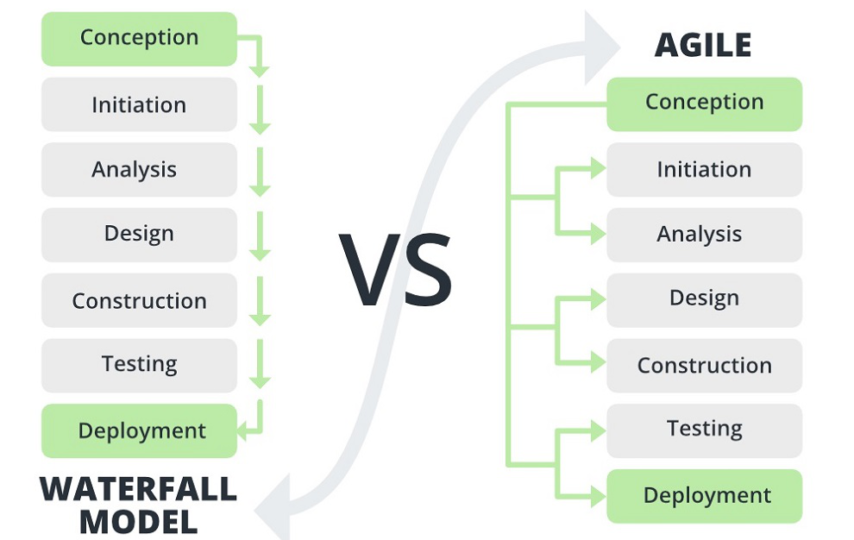As technology advances, software development is becoming more prevalent than ever. To deliver exceptional software products that are superior in quality, it is essential to utilize a methodology that best fits the corporation’s needs.
Agile and Waterfall are some of the most conventional methodologies used in the IT industry to enhance the software development lifecycle. Hence, this article will focus on helping you decipher which methodology is suited for your business. Making a choice is a breeze by shedding light on each method’s uses and benefits.
What is Agile Methodology?
Renowned for its adaptability and flexibility, Agile is one of the up-and-rising methodologies. Working in a short development phase known as ‘sprints’, it works by meeting project deliverables with a minimum viable product (MVP) or minimum loveable product (MLP). Depending on many factors, Agile is utilized for dynamic and fast-paced projects with ever-changing timelines or demands.
Advantages of Agile Methodology
Like all systems and software, they come with pros and cons.
In this section, we’ll be reviewing the benefits of using Agile.
Flexibility
Agile is typically encouraged in challenging projects requiring fast-paced environment changes. Since it adopts a quick-and-easy approach, it is most beneficial for corporations with changing demands due to Agile’s prompt and straightforward adaptability.
Faster Delivery
Due to its implementation of MVPs, Agile has a shorter development cycle than Waterfall. As it focuses on introducing the product earlier into the market, its efficient implementation sets expectations and improvements for firms to improvise accordingly.
Continual Improvisation
Because of its early delivery with testing of all minimum viable products, getting constructive feedback is inevitable. The more testing is done, the more improvements are realized to optimize customer satisfaction. With the addition of continual improvising done to resolve incoming feedback, the product created usually has higher quality since it is specially curated with ongoing changes.
What is Waterfall Methodology?
Famed for its structure and progressive approach, Waterfall is usually a go-to for many organizations. One of its best features is moving on to the next phase with strategic planning after reaching a milestone. With its formality and organized prioritization, it is no wonder that Waterfall is best suited for well-established projects in terms of deadlines and technical requirements.
Advantages of Waterfall Methodology
Despite Agile’s speedy improvisation and improvements, Waterfall’s benefits set it apart.
Predictable Expectations
Unlike Agile, Waterfall requires strategic planning to establish the project’s requirements beforehand. Attributed to how it works by moving on to the next cycle after a phase is completed, the organization is unparalleled in this methodology.
Detailed Documentation
For each phase to go well, design to delivery has to be adequately documented. By providing important record-keeping, the role and function of every team member are clearly defined, which leads to a more effective workflow in smaller teams.
Suitable for Small Teams
The detailed documentation and Waterfall’s structured project management style make it a perfect assimilation for smaller teams. Merged with well-defined roles for every employee, this potent combination is a recipe for a high-quality software product.
Summary: Waterfall or Agile
The only way to choose between both methodologies is by defining specific requirements for your business and project needs. Therefore, the best choice must be assessed and analyzed, which is usually covered in a comprehensive list, such as TCGen’s best approach on product development. Here are some key aspects you can focus on to decide which methodology suits your company.
- Complexity of every project
Based on how challenging your product is, it is vital to choose a methodology based on its complexity. Waterfall is highly recommended for easier ones as it is less flexible than Agile.
- Customer or Product Centric
When your product is created, focus on which aspect takes importance. If your corporation prioritizes meeting every need of the client, Agile might be a better choice due to the possibility of constant improvisation.
- Time
For a product launched in the market, deadlines are a critical factor. Hence, it is crucial to understand your client’s needs. If time is important, MVPs from Agile methodologies are often an excellent way for a trial run.
In summary, despite their significant differences, Agile and Waterfall focus on achieving the same result: a high-performing and quality product.








